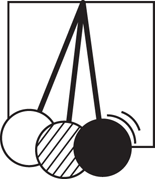
Pendulum Plus
Does the Weight of a Pendulum Affect the Timing of the Swing?
Materials
- 2 pieces of string about 5 ft (1.7 m) long
- 3 spoons
- 2 pushpins
- adult helper
Try This
- Tie one of the pieces of string to the thinnest part of one of the spoons.
- Lay the other two spoons on top of each other. Tie the second piece of string to the thinnest part of the two spoons together.
- Ask your adult helper to attach the ends of both strings to the top of a doorway with the pushpins. The strings should be about 9 in. (23 cm) apart.
- Keeping the strings straight, pull the spoons up to the same height.
- Release all the spoons at the same time and step back so you don't accidentally get hit. Which swings faster? Farther?
- Now shorten the second string in half, and remove one of the spoons, before repeating steps 3–5.
What's Going On?
Pendulums are hanging weights that swing under the influence of gravity (swing sets are pendulums). When you released them, both pendulums moved back and forth at the same time with an equal amount of force. Both went back and forth to the same distance, even though one pendulum was heavier. It seems like the heavier pendulum should swing faster, but all objects accelerate the same amount when freely falling. When you shortened the string of one pendulum, it swung faster because the string's momentum from gravity only allowed it to go a certain distance away before gravity pulled it back.
Imagine the strings were tied loosely around a tree limb. With enough energy, the spoons would go around and round the tree limb. Similarly, the moon circles around the Earth. The pulling force of the Earth's gravity is balanced by the outward force the moon feels swinging around our planet.
